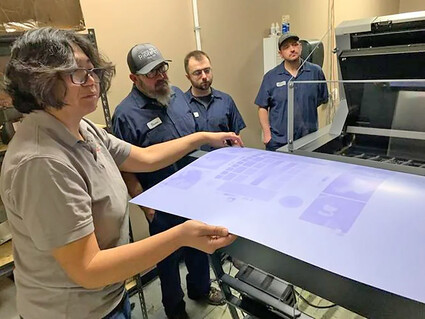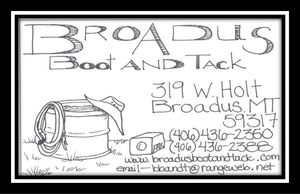Pioneer Upgrades Press Plate Technology
February 1, 2024

Kodak technician Aliza Jang, left, runs a test plate through the Black Hills Pioneer's new thermal imaging technology equipment during a training session for pressmen Brian Groves, Chris Lister, and Chris Schmidt. (Photo courtesy BH Pioneer)
By Mark Watson, Courtesy of the Black Hills Pioneer
SPEARFISH - Innovation and embracing technology is always at the forefront of the Black Hills Pioneer's mission to serve our community.
Today's Black Hills Pioneer was printed using upgraded plate technology to make our paper, and the rest of the products we produce, faster, crisper, and more efficient.
"We're excited to be upgrading our plate-making equipment to the all-new Kodak Thermal Imaging technology," said Letti Lister, publisher of the Black Hills Pioneer. "This major investment will provide us with excellent image accuracy and stability on our plates, resulting in an even better final printed product, all while using significantly less energy, and waste."
Kodak officials spent last week installing the new equipment and preparing to run the first plates.
On Wednesday, Scott Lister, production manager for the Pioneer, said the new equipment is a tremendous asset for the Pioneer.
"This piece of technology is state of the art and a huge benefit to our paper and readers," Scott said. "The thermal imaging plates that this technology uses are made in the USA taking our order lead time from 90 days down to 40 days. While there is less-expensive equipment available, we feel Kodak, and its solid reputation, and proven track record made it the best company to choose for our long-term business plan."
The daily newspaper is designed using the computer program Adobe InDesign.
Using computer-to-plate technology, the new Kodak Thermal Imaging Technology equipment and associated software, automatically splits the digital image, depending on how many pages are in the specific edition of the paper, and transfers those images onto an aluminum plate using a laser.
There are no chemicals used in the process.
Those plates are then hung on one of our eight Goss Community Press units. The plates are spun on a rotating drum picking up soy-based ink. That ink is transferred to a "blanket" which then transfers the ink to rolls of paper.
This is the second major upgrade to plating technology in the last 13 years.
The first upgrade, in 2010, sped up the plating process significantly.
This upgrade speeds it up even further.
Once the product is designed in lay-out, all plates are ready to hang on the press in 30 minutes, a significant improvement from the previous machine that took about 45 minutes and required a staffer to manually run the plates through one by one.
The Kodak machine automatically loads and develops the plates freeing up our pressmen to focus on printing.
All the plates, once done with printing, are recycled for their aluminum and silver recovery, as is the minimal amount of waste newsprint.
"We are conscious about the waste that we create and recycle as much as we can. Even our shop rags are recycled surgical cloths that have been sanitized," Lister noted.
"We wholeheartedly believe in our local news industry and in the importance of the permanent printed word along with digital platforms," Letti Lister said. "We have focused on becoming a reliable print-hub, with our crew currently printing seven weekly newspapers for publishers in South Dakota, Wyoming, and Montana (including the Examiner - Ed), in addition to our own products, handling an average of more than 500,000 pieces per week."
"Since our first edition published on June 8, 1876, we have had long and steadfast community support for our newspapers," she added. "It would be impossible to do what we do without our readers and advertisers."





Reader Comments(0)